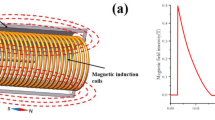Abstract
A new tool strengthening method for micro-tools using pulsed magnetic treatment has been experimentally investigated. Compared with the conventional tool strengthening method, the pulsed magnetic treatment of micro-tools enables effectively reduce tool wear both by improving the mechanical properties of the tool material and changing the tool-chip contact friction mechanism which results in efficient chip removal and good surface quality. On account of this method, the untreated and treated micro-tools and three different magnetic properties of ferromagnetic, paramagnetic, and diamagnetic workpiece materials were used to perform comparative cutting experiments. The tool wear, cutting force, and surface roughness were measured to quantitatively investigate the influence of magnetic treatment on the micro-cutting process. Results showed that wear resistance of micro-tools could be improved when machining ferromagnetic and paramagnetic materials, of which the minor flank wear could be reduced by up to 56%. However, the tool wear increased when machining the diamagnetic materials. On the basis of relationship between micro-tool, micro-chip, and workpiece, the machining mechanism is analyzed in detail in pulsed magnetic treatment for micro-tools.
Similar content being viewed by others
References
Dehghani A, Amnieh SK, Tehrani AF, Mohammadi A (2017) Effects of magnetic assistance on improving tool wear resistance and cutting mechanisms during steel turning. Wear 384-385:1–7
Batainech O, Klamecki B, Koepke BG (2003) Effect of pulsed magnetic treatment on drill wear. J Mater Process Tech 134(2):190–196
Mansori ME, Pierron F, Paulmier D (2003) Reduction of tool wear in metal cutting using external electromotive sources. Surf Coat Tech 163(2):472–477
Mansori ME, Iordache V, Seitier P, Paulmier D (2004) Improving surface wearing of tools by magnetization when cutting dry. Surf Coat Tech 188(1):566–571
Mansori ME, Geoffroy R, Paulmier D (2003) Tool wear in magnetized drilling process. National tribology conference, the annals of university “DUNAREA DE JOS” of Galati, fascicle VIII, tribology. September 24-26:363–368
Mansori ME, Mkaddem A (2007) Surface plastic deformation in dry cutting at magnetically assisted machining. Surf Coat Tech 202(4):1118–1122
Fahmy Y, Hare T, Tooke R, Conrad H (1998) Effects of a pulsed magnetic treatment on the fatigue of low carbon steel. Scrip Mater 38(9):1355–1358
Bose M (1984) Effect of saturated magnetic field on fatigue life of carbon steel. Phys Stat Sol (a) 86(2):649–654
Chin KJ, Zaidi H, Nguyen MT, Renault PO (2001) Tribological behavior and surface analysis of magnetized sliding contact XC 48 steel/XC 48 steel. Wear 250(1):470–476
Zaidi H, Senouci A (1999) Influence of magnetic field on surface modification and the friction behavior of sliding couple aluminium/XC 48 steel. Surf Coat Tech 120(1):653–658
Zaidi H, Pan L, Paulmier D, Robert F (1995) Influence of a magnetic field on the wear and friction behaviour of a nickel/XC 48 steel couple. Wear 181–183:799–804
Tang F, Lu AL, Mei JF, Fang HZ, Luo XJ (1998) Research on residual stress reduction by a low frequency alternating magnetic field. J Mater Process Tech 74(1):255–258
Lu AL, Tang F, Luo XJ, Mei JF, Fang HZ (1998) Research on residual-stress reduction by strong pulsed magnetic treatment. J Mater Process Tech 74(1):259–262
Kumagai K, Suzuki K, Kamiya O (1993) Study on reduction in wear due to magnetization. Wear 162–164:196–201
Chin KJ, Zaidi H, Mathia T (2005) Oxide film formation in magnetized sliding steel/steel contact—analysis of the contact stress field and film failure mode. Wear 259(1):477–481
Zaidi H, Amirat M, Frene J, Mathia T, Paulmier D (2007) Magnetotribology of ferromagnetic/ferromagnetic sliding couple. Wear 263(7):1518–1526
Mansori ME, Zadi H, Kadiri EK, Paulmier D (1996) Surface modifications of a non-ferromagnetic copper/ferromagnetic steel XC48 couple in magnetized sliding contact. Surf Coat Tech 86(1):511–515
Mansori ME, Paulmier D (1999) Effects of selective transfer on friction and wear of magnetised steel–graphite sliding couples. Appl Surf Sci 144(1–4):233–237
Paulmier D, Mansori ME, ZaiDi H (1997) Study of magnetized or electrical sliding contact of a steel XC48/graphite couple. Wear 203:148–154
Wang B, Yin WD, Wang MH, Zheng YH, Li XP, Ma ZB (2017) Edge chipping mechanism and failure time prediction on carbide cemented tool during drilling of CFRP/Ti stack. Int J Adv Manuf Technol 91:3015–3024
Ma LP, Zhao WX, Liang ZQ, Wang XB, Xie LJ, Jiao L, Zhou TF (2014) An investigation on the mechanical property changing mechanism of high speed steel by pulsed magnetic treatment. Mat Sci Eng A-Struct 609:16–25
Ma LP, Liang ZQ, Wang XB, Zhao WX, Jiao L, Liu ZB (2015) Influence of pulsed magnetic treatment on microstructures and mechanical properties of m42 high speed steel tool. Acta Metall Sin 51:307–314
Liang ZQ, Ma LP, Wang XB, Xie LJ, Zhao WX, Yao HM (2015) The effect of pulsed magnetic field on friction and Wear properties of high speed steel tool materials. Acta Armamentarii 36(5):904–910
Mansori ME, Schmitt M, Paulmier D (1998) Role of transferred layers in friction and wear for magnetized dry frictional applications. Surf Coat Tech 108(1):479–483
Funding
This work was supported by National Natural Science Foundation of China (No. 50935001, No. 51575049, and No. 61673383).
Author information
Authors and Affiliations
Corresponding author
Rights and permissions
About this article
Cite this article
Ma, L., Wang, X., Liang, Z. et al. Machining mechanism in pulsed magnetic treatment for micro-tools. Int J Adv Manuf Technol 101, 2391–2406 (2019). https://doi.org/10.1007/s00170-018-3105-4
Received:
Accepted:
Published:
Issue Date:
DOI: https://doi.org/10.1007/s00170-018-3105-4




